
Traditional Marketing and Digital marketing are two distinct approaches for promoting products or services to a target audience. Traditional Marketing involves traditional channels such as television, radio, newspapers, magazines, billboards, direct mail, and flyers. Digital Marketing utilises Digital platforms and technologies, including websites, social media, email, search engines, online ads, and mobile apps.
Importance of Understanding the Differences in today’s Business Purview:

Understanding the differences between Traditional Marketing and Digital Marketing is essential for creating effective strategies. With consumers increasingly turning to Digital platforms for information and purchases, businesses must recognize the distinct advantages and limitations of each Marketing approach. This knowledge enables companies to allocate resources efficiently and maximise their outreach and impact.
In this blog we are providing a comprehensive analysis of Traditional Marketing vs Digital Marketing. By decoding these two paradigms, we aim to help businesses, marketers, and entrepreneurs make informed decisions on where to focus their efforts. Whether you’re a startup or an established enterprise, understanding these differences can significantly enhance your Marketing strategy and drive better results.
Decoding Traditional Marketing vs Digital Marketing:
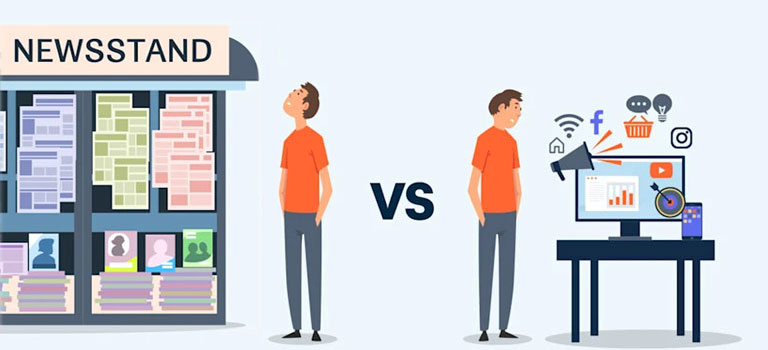
Definition and Characteristics of Traditional Marketing

Traditional Marketing refers to conventional methods of promoting products and services to consumers. This form of marketing has been used for decades and relies on offline channels to reach a broad audience. Key characteristics of Traditional Marketing include its tangible nature, the ability to target a local audience effectively, and a one-way communication model where businesses broadcast their message to potential customers without immediate feedback.
Examples of Traditional Marketing
Print Advertising
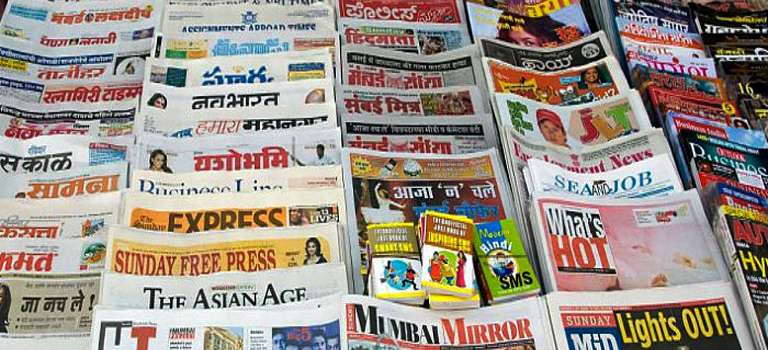
Print advertising is one of the oldest forms of Traditional Marketing. It involves placing ads in newspapers and magazines to reach readers. These ads can range from small classified listings to full-page spreads, depending on the budget and marketing goals. Print advertising is particularly effective for targeting specific demographics based on the publication’s readership.
Television and Radio Commercials

Television and radio commercials are powerful tools in Traditional marketing. TV ads have the advantage of combining visuals and sound to create engaging messages, while radio ads rely on audio to capture the listener’s attention. These commercials can reach a wide audience, making them suitable for mass marketing campaigns. The high production costs and time constraints are notable considerations for businesses opting for this medium.
Telemarketing

It is the practice of calling prospective customers on the phone to solicit interest in a product or service. It is commonly used by Institutions like Banks, Corporates and other institutions. They Gather the Telephone numbers through various sources and then call and Target Customers to go in for their Services or Products.
Billboards and Posters

Billboards and posters are essential components of outdoor advertising. Strategically placed in high-traffic areas, they are designed to capture the attention of passers-by. Billboards are typically large and visible from a distance, while posters are smaller and often found in specific locations like bus stops or subways. These forms of advertising are effective for creating brand awareness and reinforcing marketing messages through repeated exposure.
Definition and Characteristics of Digital Marketing

Digital Marketing refers to the use of Digital channels, platforms, and technologies to promote products and services. Digital Marketing is more targeted and cost-effective, allowing businesses to precisely reach their desired audience. Unlike Traditional Marketing, which relies on physical media like print ads and billboards, Digital Marketing leverages the internet and electronic devices to reach a global audience. Its key characteristics include real-time data analytics, targeted advertising, cost-effectiveness, and interactive engagement with consumers. Digital Marketing strategies can be customised to meet the specific needs of different segments, making it a versatile tool for businesses of all sizes. In contrast, Traditional Marketing tends to have a more generalised, broad-based approach.
Examples of Digital Marketing
Digital Campaigns

Digital campaigns are multifaceted marketing efforts that utilise various online platforms to engage potential customers. Common examples include roadblocks, Digital displays, and banner ads. Roadblocks refer to a synchronised takeover of Digital ad spaces across multiple platforms, ensuring maximum visibility. Digital displays are visually engaging ads that appear on websites, apps, and Digital billboards, often using rich media content like videos and animations. Banner ads are graphical advertisements displayed on web pages, designed to attract clicks and drive traffic to the advertiser’s site. These campaigns can be precisely targeted and monitored for performance in real time.
Social Media Marketing
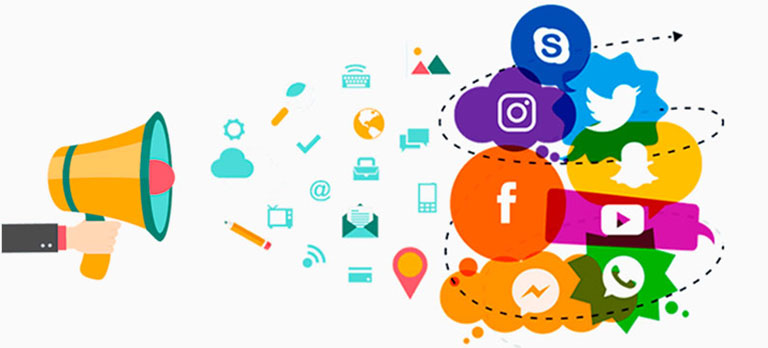
Social media marketing involves using platforms like Facebook, Instagram, and X (Twitter), Linkedin to connect with audiences, build brand awareness, and drive sales. On Facebook, businesses can create tailored ads based on user demographics and behaviours, engage with followers through posts and comments, and leverage tools like Facebook Live for real-time interaction. Instagram offers visual storytelling through images, videos, and Stories, allowing brands to showcase their products creatively. Twitter provides a platform for real-time updates, customer service, and engagement through tweets and trending hashtags. Social media marketing allows for direct communication with consumers and the ability to build a loyal online community.
7 Key Differences between Traditional Marketing and Digital Marketing
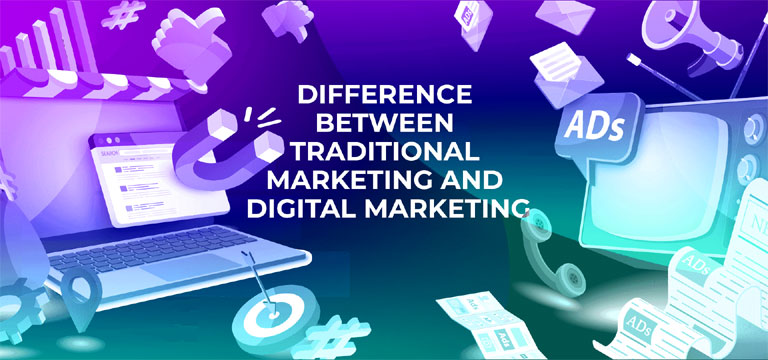
1- Medium of Promotion
Traditional Marketing: involves traditional channels such as television, radio, newspapers, magazines, billboards, direct mail, and flyers.
Digital Marketing: Utilises Digital platforms and technologies, including websites, social media, email, search engines, online ads, and mobile apps.
2- Reach and Targeting
Traditional Marketing: Generally has a broader reach and less precise targeting. Advertisements are exposed to a wide audience, including those who may not be interested in the product or service.
Digital Marketing: Offers highly targeted campaigns, allowing businesses to reach specific demographics, interests, behaviours, and locations. This can lead to a higher return on investment (ROI) by reaching a more relevant audience.
3- Cost and ROI
Traditional Marketing: Can be more costly, especially for advertising on popular platforms like television or in print publications. Measuring the ROI can be challenging.
Digital Marketing: Generally more cost-effective, and ROI can be tracked more accurately through analytics tools. Advertisers can optimise campaigns in real time to improve performance and efficiency.
4- Interaction and Engagement
Traditional Marketing: Provides limited interaction with the audience. It’s a one-way communication where the audience receives the message without immediate interaction.
Digital Marketing: Allows for real-time interaction, engagement, and feedback from the audience. Businesses can engage customers through comments, messages, reviews, and other interactive features.
5- Flexibility and Adaptability
Traditional Marketing: Often requires significant lead time for planning and executing campaigns. Changes or modifications to campaigns can be time-consuming and expensive.
Digital Marketing: Offers flexibility and agility. Campaigns can be adjusted quickly based on real-time data and insights. A/B testing and optimization are common practices.
6- Measurability and Analytics
Traditional Marketing: Measuring the success of a campaign is often challenging, with limited data available to analyse its effectiveness accurately.
Digital Marketing: Provides comprehensive analytics and data, allowing businesses to track the performance of their campaigns in detail. Metrics such as impressions, clicks, conversions, and customer behaviour can be measured and analysed.
7- Global vs. Local Reach
Traditional Marketing: Can have a local or regional focus, making it suitable for businesses targeting specific geographic areas.
Digital Marketing: Offers a global reach, allowing businesses to target audiences not only locally but also nationally and internationally.
Advantages and Disadvantages of Traditional Marketing
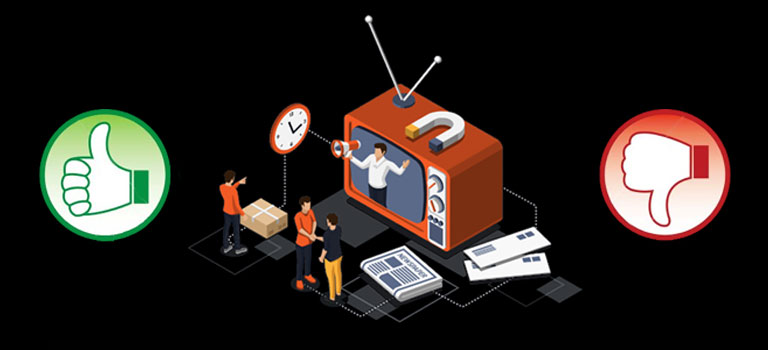
Advantages of Traditional Marketing
Builds Trust and Credibility:

Traditional marketing methods, such as print advertisements, television commercials, and radio spots, have been in use for decades. These mediums have a long-standing presence and are often perceived as more trustworthy. The tactile experience of a printed brochure or the consistent presence of a TV ad can instil a sense of reliability and credibility among consumers. This trust is invaluable, especially for established brands seeking to reinforce their market position.
Builds Brand Recognition Through Repetition:
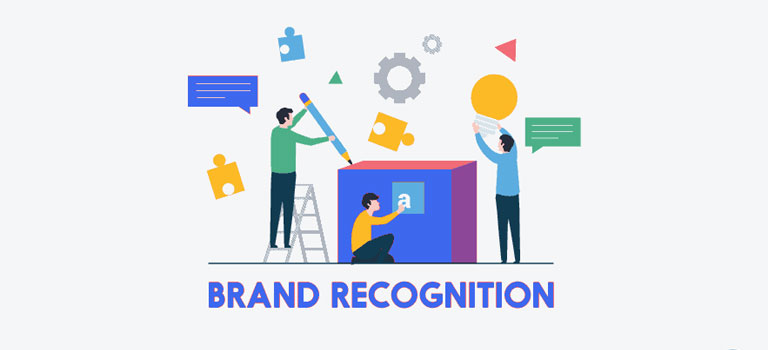
Repetition is a key factor in brand recognition, and Traditional Marketing excels in this aspect. By consistently placing ads in newspapers, magazines, and on billboards, brands can ensure their message is seen repeatedly by a broad audience. This repeated exposure helps in etching the brand into the consumer’s memory, fostering brand recall and loyalty over time.
Disadvantages of Traditional Marketing:
Limited Audience Targeting:

One of the significant drawbacks of Traditional Marketing is its limited ability to target specific demographics. Traditional media often caters to a broad audience, making it challenging to tailor messages to specific segments effectively. For instance, a newspaper ad might reach a wide range of readers, but only a small fraction may be the brand’s actual target audience. This lack of precision can lead to inefficient use of marketing budgets and less impactful campaigns.
Advantages and Disadvantages of Digital Marketing

Advantages of Digital Marketing:
Targeted Audience Reach

Digital Marketing excels in reaching specific audience segments with precision. Unlike Traditional Marketing, which often casts a wide net, Digital Marketing utilises data analytics and algorithms to target potential customers based on their demographics, interests, and online behaviour. This targeted approach ensures that marketing efforts are more effective and efficient, leading to higher conversion rates and better return on investment (ROI).
The Search Engine Optimisation (SEO), Search Engine Marketing (SEM), Social Media Optimisation (SMO) and Social Media Marketing (SMM) services in this Field offer a great contribution in the Precise Targeting of the Desired Audience.
Cost Effective

Digital Marketing offers cost-effective solutions for businesses of all sizes. It is generally more cost-effective than Traditional Marketing, with options suitable for various budget sizes. Small and medium enterprises (SMEs), in particular, can leverage Digital Marketing to compete with larger corporations without breaking the bank. Platforms like social media, email marketing, and pay-per-click (PPC) advertising provide scalable options that can be tailored to fit various budget constraints, maximising reach and impact without the need for substantial financial investment.
Builds Credibility

Another significant advantage of Digital Marketing is its ability to build credibility. When Digital ads are placed in brand-safe publisher environments, they benefit from the trust and reputation of these platforms. This association enhances the credibility of the advertised brand, making potential customers more likely to engage with the content and consider the products or services being offered.
The Campaign Performance can be Tracked

Detailed analytics and metrics provide measurable results, making it easy to track campaign performance.
Offers Flexibility
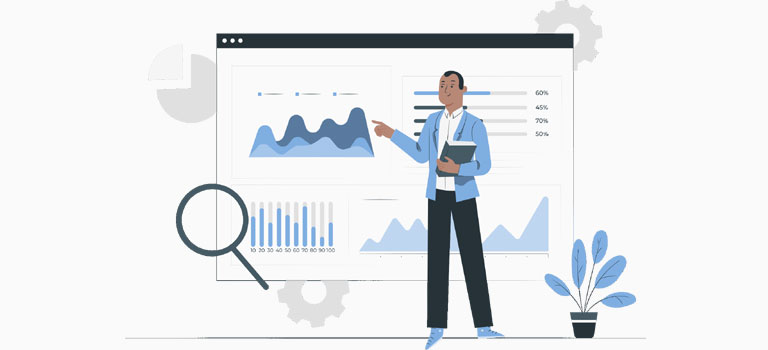
Digital Marketing also offers flexibility, as campaigns can be quickly adjusted based on performance data. This saves and cuts down the Advertisement costs.
Direct Engagement with Audience

The interactive elements like social media and email enable direct engagement with the audience.
Disadvantages of Digital Marketing:
Requires Constant Adaptation
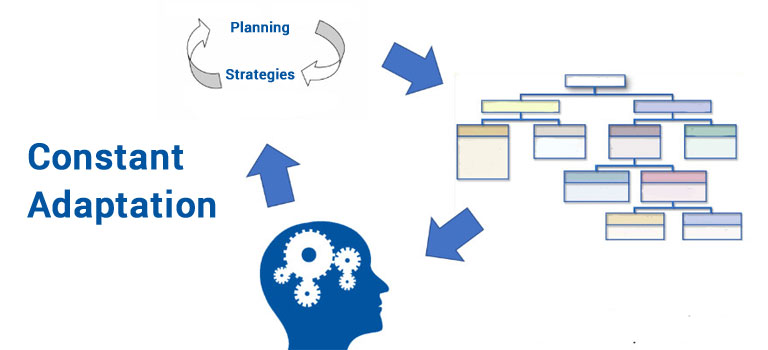
One of the primary challenges of Digital Marketing is the need for constant adaptation. The Digital landscape is continuously evolving, with new trends, technologies, and algorithms emerging regularly. Marketers must stay up-to-date with these changes and adjust their strategies accordingly to remain effective. This constant need for adaptation can be resource-intensive and requires a commitment to ongoing learning and flexibility.
Challenging to stand out

The Digital space can be crowded, making it challenging to stand out. The use of ad blockers by some users can reduce the effectiveness of online ads. Digital Marketing depends heavily on technology, requiring reliable internet access and being susceptible to technical issues. Increasing concerns over data privacy and the ethical use of personal information can also impact Digital Marketing strategies and user trust.
Conclusion

Traditional forms of marketing blossomed in the middle and late parts of the 20th century, although the roots stretch much further back. When you watch a TV commercial, Listen to an Advertisement on the FM, read an advertisement in a magazine, newspaper or watch a billboard you’re engaging with Traditional Marketing. The traditional methods of marketing have been a boon for big businesses who can shell out the money for high profile and prime time ads.
With Digital Marketing on the rise, even small businesses get a chance to put together a solid marketing strategy as Digital Marketing encompasses the online world. All they need is a website with a fast response time and quality content. A well thought out marketing strategy can easily increase the site traffic by leaps and bounds. You also don’t need to wait for the statistics to find out if your strategy worked. With Digital Marketing, the ad reach is immediately converted to purchase. So, the business owners would know what worked and what didn’t in almost no time and they could change their marketing strategy.
Both approaches have their advantages and are often used in conjunction to create comprehensive marketing strategies. The choice of using Digital Marketing, Traditional Marketing or a combination of both depends on the nature of the business, target audience, budget, and marketing objectives. However, after going through this post and analysing we can easily assume that Traditional Marketing is slightly losing its place in today’s Digitally Developing world.
Digital Azadi Student – Arun Mehrotraa

- https://www.htmedia.in/blog/traditional-marketing-vs-digital-marketing-key-differences
- https://www.designrush.com/agency/digital-marketing/trends/digital-vs-traditional-marketing
- https://byjusexamprep.com/gate-cse/difference-between-traditional-marketing-and-digital-mark
- https://emfluence.com/blog
- www.digimarkagency.com/blog
- https://fastercapital.com/topics/
- https://creativethinksmedia.com
- https://online.mason.wm.edu/blog/
जानकारी को पेश करने का आपका प्रयास सराहनीय है